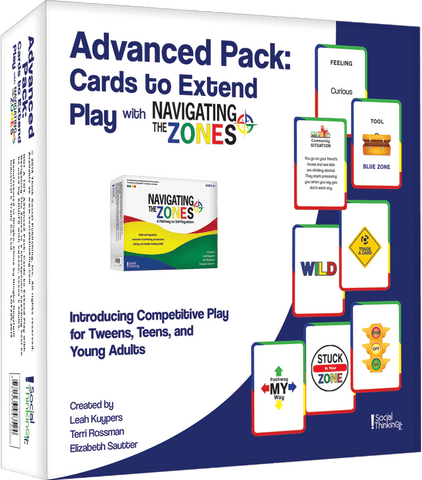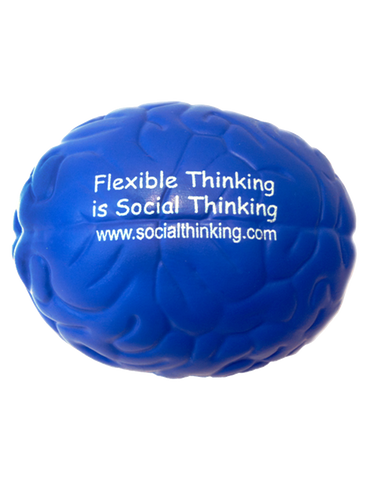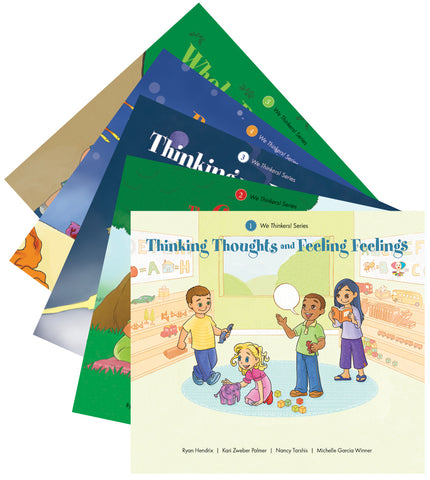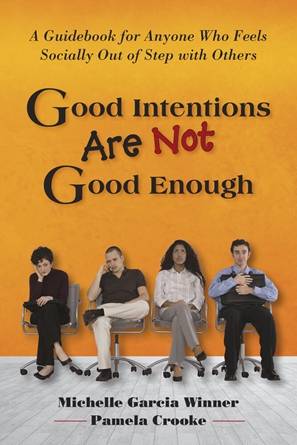
Zones of Regulation
Inclusivity and representation of all learners are important to us! We are pleased to announce that we have included a more diverse representation of characters within our Zones emotions illustrations throughout the 2021 printing of the curriculum book. While eight characters can’t possibly embody all the spectrum of humanity, we hope that learners see glimpses of themselves and those they know among this new cast. Download the new free Zones Emotions Reproducibles.
Please note: There are copies of this book in circulation with a USB that may not include these newly updated illustrations. Updated versions of select Reproducibles are available for download to all The Zones of Regulation curriculum users.
The Zones of Regulation: A Curriculum Designed to Foster Self-Regulation and Emotional Control
This popular, easy-to-use regulation framework and award-winning curriculum teaches strategies for managing emotions and sensory needs to children, students, and clients ages 4+. Rooted in cognitive behavioral therapy, The Zones framework uses four colors to help individuals identify how they are feeling in the moment given their energy, emotions, and level of alertness, creating a colored system to guide them to metacognitive strategies and tools to support regulation. By understanding how to read their bodies, detect triggers, think about the social context, and consider their reactions, individuals learn how to increase their ability to regulate their emotions, manage their sensory needs, and become more self-aware and skillful problem solvers. Activities and reproducible handouts and visuals are included in the curriculum along with instructions for digital access. Select updated Emotions Reproducibles are available for download to all The Zones of Regulation curriculum users. All products which extend teaching about The Zones of Regulation require the use of this curriculum to teach with fidelity.
What are the Four Zones of Regulation?
Feelings come in different sizes, intensity, and levels of energy. To make this easy to talk and think about, we can categorize them into four simple, colored categories that we call Zones of Regulation.
The Red Zone is used to describe extremely heightened states of alertness and intense emotions. A person may be elated, euphoric, or experiencing anger, rage, explosive behavior, devastation, or terror when in the Red Zone.
The Yellow Zone is also used to describe a heightened state of alertness and elevated emotions, however individuals have more control when they are in the Yellow Zone. A person may be experiencing stress, frustration, anxiety, excitement, silliness, the wiggles, or nervousness when in the Yellow Zone.
The Green Zone is used to describe a calm state of alertness. A person may be described as happy, focused, content, or ready to learn when in the Green Zone. This is the zone where optimal learning occurs.
The Blue Zone is used to describe low states of alertness and down feelings such as when one feels sad, tired, sick, or bored.
All of the zones are natural to experience, but the framework focuses on teaching students how to recognize and manage their zone based on the demands of their environment and the people around them. Learn more in the article, All the Zones are OK! Tips for Managing the Zones You’re In.
Learners explore regulation tools and strategies that can include mindfulness, sensory-based, movement-based, play-based, thinking strategies, wellness activities, and healthy connection with others. Learners negotiate which Zone(s) each tool would help regulate, building a system to use tools to manage a Zone or move from one to another. Ultimately, they create their individualized toolbox and develop a cognitive pathway or mind-map to guide them in regulating their Zones. Integrating cognitive behavior therapy principles, learners build skills in consciously regulating their feelings and actions, managing their sensory needs, problem solving, and developing executive functions and social competencies. To deepen learners’ understanding of how to regulate, the lessons set out to teach a number of skills, including reading others’ facial expressions a body language, recognizing a broader range of emotions in others and themselves, noticing the body signals that come with their feelings, understanding the context of the situation, insight into events that trigger their less regulated Zones, when and how to use regulation tools, and why regulation matters in relation to their overall wellness and personal goals. The framework is designed to help move learners toward more independent regulation while also honoring and respecting each unique individual. Concepts from the Social Thinking® Methodology are incorporated throughout the curriculum to help learners develop perspective taking, as well as understand the social context of a situation, both of which are factors that come into play when determining how to regulate oneself.
Who can teach The Zones of Regulation?
The Zones curriculum can be taught by anyone wanting to support individuals in fostering their regulation skills. This can include, but is not limited to, special and regular education teachers, occupational therapists, speech-language pathologists, psychologists, counselors, behaviorists, social workers, and caregivers.
Who can benefit from The Zones?
The Zones curriculum targets learners who need support with self-regulation. Initially it was developed considering the needs and learning styles of Neurodivergent learners, but all kids can benefit from learning about their own emotions and tools. Everyone experiences difficulties in self-regulation from time to time. Because The Zones of Regulation curriculum provides a universal common language, consistent visual structure, and equitable support for all learners, many general education teachers have adopted it for use with their whole class. In fact, entire districts have adopted it as a schoolwide proactive intervention.
You may be interested in this published study of a public school district’s adoption of The Zones of Regulation curriculum as part of comprehensive mental health program in five schools to improve school safety.
Lessons are designed to be used with learners ages four through adulthood. Where relevant, the lessons suggest ways to differentiate activities with learners of varying ages and learning characteristics. The depth of understanding will vary, and teaching expectations need to be tailored based on the person. Some accommodations are provided to adapt activities. Lessons may require further adaptation when teaching students with cognitive challenges.
Download Zones Handouts
Enjoy three widely used handouts or “Reproducibles” from the book in digital form! These tools are designed for professionals who are using The Zones of Regulation curriculum to share with the stakeholders and families of their students and clients to continue the learning at across settings. Download the Reproducibles to make the concepts accessible for all.
• English: Reproducible A, Reproducible B, Reproducible E
About the Author
Leah Kuypers, MA Ed., OTR/L, is the creator of The Zones of Regulation®, a framework designed to teach self-regulation. She is the author of the book and two apps by the same name. In addition to working with students, Leah provides trainings and consultation to parents and professionals on self-regulation and challenging behavior, and conducts workshops on The Zones framework to groups around the world. Explore her webinars and trainings on her website, www.zonesofregulation.com. She resides in Minneapolis, Minnesota, with her husband, son, daughter, and their dog.



